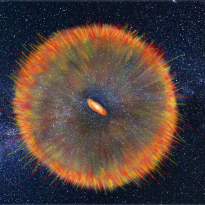Astronomers witness a “heat-wave” of thermal energy radiating outward from a high-mass protostar.

The constellations are populated with dozens of bright stars that have masses equivalent to many tens the mass of the Sun. However, the current best star formation theories predict the intense radiation of these formative high-mass "protostars" should limit their mass growth to around eight times the mass of the sun. The disagreement between theory and reality has troubled astronomers for decades, with several competing theories emerging, each attempting to complete the theory of high-mass star formation. One such theory proposes that high-mass protostars gather their mass via brief bursts of `episodic accretion'. The theory predicts short, intense accretion bursts in which the protostar gains mass from its surrounding accretion disk, followed by long periods of inactivity lasting hundreds, to thousands of years. Furthermore, high-mass protostars reside deeply embedded in cocoons of natal gas and dust, allowing high-mass protostars to evade the scrutiny of optical telescopes.
In January 2019 astronomers at Ibaraki university, Japan, noticed that one such high-mass protostar called G358-MM1, showed signs of new activity indicative of a potential accretion burst. In response, a collaboration of astronomers called the Maser Monitoring Organisation (M2O) gathered several radio telescopes from Australia, New Zealand and South Africa to form a telescope array capable of detecting emission stimulated by the heat of the accreting protostar. The team, lead by Ross Burns of the National Astronomical Observatory of Japan compared multiple images spaced a few weeks apart to reveal a "heat-wave" of thermal energy radiating outward from the location of G358-MM1. The cause of the heat-wave was later confirmed to originate in an accretion event by the plane-borne SOFIA telescope. "The M2O observations are the first to witness the immediate aftermath of an accretion burst in a high-mass protostar in such detail, which provide evidence in support of the `episodic accretion' theory of high-mass star formation. Our team greatly benefits from close communication between a diverse, global community of observers, astrophysicists and theorists in planning, executing and interpreting transient maser events" says Ross Burns. The result, published today in Nature Astronomy, will be followed by a series of deeper investigations into the nature of high-mass protostars, their formation mechanisms and their environments.
Original Paper
"A heatwave of accretion energy traced by masers in the G358-MM1 high-mass protostar" R. A. Burns et.al. 2020
Figure caption
Obsevation Result: Data from the radio telescope array show a ring of methanol maser emission which traces the heat-wave as it propagates outward from the position of the high-mass protostar which is represented by a white cross. The colours indicate the velocity of the gas motion in direction of the observer’s the line of sight. Credit: NAOJ/Burns et al.
Artist's illustration: Artist illustration of the "heat-wave" Credit: Katharina Immer
Reference.
M20 HOME
CSS not active
JavaScript not active


